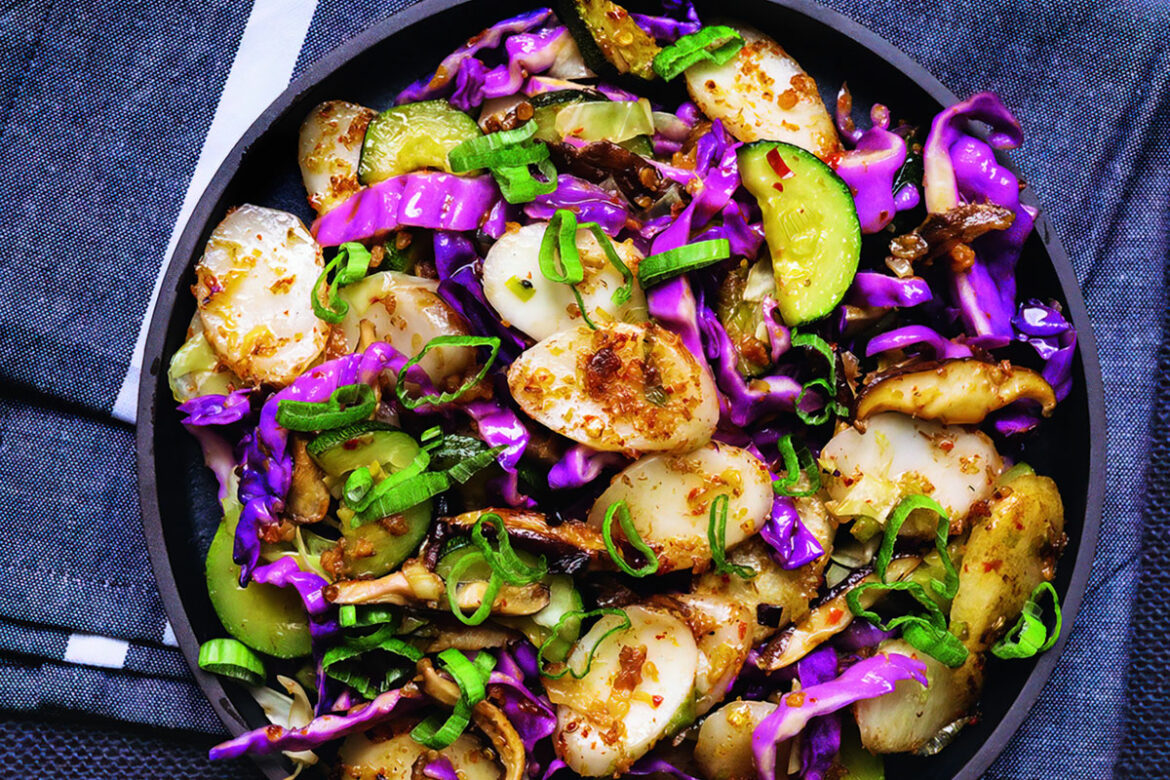Diana Kuan knows what kind of recipes people want. The author of 2012’s The Chinese Takeout Cookbook and 2019’s Red Hot Kitchen: Classic Asian Chili Sauces From Scratch and Delicious Dishes to Make With Them is on the ground, teaching cooking classes in both Brooklyn and Beijing, and she’s noticed a swing toward the spicy end of the flavor spectrum.
That’s why Red Hot Kitchen, while not an encyclopedia of chili sauces from the continent, introduces unfamiliar readers to a broad swath of sauces, from Indonesia and Malaysia’s sambals to Thailand’s sriracha to Hong Kong’s XO. With brief histories, a guide to chilies and ingredients, and recipes for how to put each sauce to use, it’s a primer on heat written for ease and approachability.
Edible Brooklyn talked to Kuan to get a deeper sense of why 2019 was the right time for this book and how she developed its vegetarian-friendliness.

Edible Brooklyn: Why build a book around chili sauces?
Diana Kuan: I’ve been teaching cooking classes for almost 10 years, and in recent years students have been requesting more and more classes and dishes that have bold, spicy flavors. For example, when I first started teaching, there weren’t many people in the U.S. who had even tasted Sichuan pepper in a restaurant; nowadays, students will easily rattle off a list of their favorite Sichuan dishes that they want to learn. Most hot sauce cookbooks on the market focus on Western-style sauces, telling readers to make them as scorchingly hot as possible. I wanted to write a book that focused on hot sauces from around Asia, that also emphasized using various chilies in balance with many other flavors. Making the chili sauces customizable in terms of spiciness level will also hopefully allow readers who aren’t hot sauce fiends (yet!) to comfortably ease their way into the world of hot sauces.
EB: The word “Asian” covers a broad range of cultures and cuisines. How did you define it while you worked on this book and focused its recipes?
DK: I didn’t want this book to be an encyclopedia of chili sauces from around East and Southeast Asia. Even something that’s seemingly as basic as sambal has enough varieties to fill volumes. Instead, I decided to narrow the list down to nine very versatile chili sauces that can be used as both a condiment and cooking ingredient. And I wanted a wider geographic area. Thailand obviously comes to mind when people think of spicy Asian cooking, and the book does include four Thai chili sauces. But I also highlighted sambal oelek from Indonesia, Sichuan chili oil from China, XO sauce from Hong Kong, gochujang from Korea and yuzu kosho from Japan.

EB: There are a lot of, if not vegan, vegetarian dishes in this book. Was that a conscious choice?
DK: I’ve been eating less and less meat in the past couple of years, so most of my cooking at home these days is either vegetarian or pescatarian. And after submitting my book proposal, which had mostly traditional recipes, my publisher had asked if I could include a few more vegetarian dishes, so I felt freer to include new dishes that I experiment with at home using whatever fresh produce I find at the farmers markets. There are a lot of East and Southeast Asian recipes that traditionally involve pork, shellfish or fish sauce, but they were easy to adapt for a vegetarian or vegan kitchen. Overall, about 75 percent of the 100 or so recipes are vegetarian, though that still leaves plenty of the more traditional dishes for the omnivore.
EB: Sriracha (or Huy Fong’s version) has become a staple, and chili crisp has become a go-to store-bought condiment. Why should people instead make these sauces at home?
DK: Homemade is better! Most store-bought sauces, however minimal the number of ingredients, still contain some sort of stabilizer or preservative. When you make your own hot sauces at home, the chilis, salt and vinegar take care of the preservation part for you. Obviously you can still make the dishes in Red Hot Kitchen with store-bought sauces, but if you DIY you can customize the spiciness to your ideal level. Don’t think store-bought Sriracha is hot enough? Use serrano chilis instead of jalapeño! Need your Sichuan chili crisp to be crispier? Add more dried red chilis! Plus, it’s incredibly meditative to experiment with hot sauces in your kitchen, trying to attain the ideal spiciness level or texture. I’m hoping readers will find it as rewarding as making homemade pickles, jam or sourdough bread.

Vegan XO Sauce
Makes 2 cups
Dried shiitake mushrooms, caramelized shallots and a bit of cumin are the keys to getting the meaty taste of the seafood and bacon XO sauce. The yield for this recipe is less than in the recipe for traditional XO sauce because it keeps for only 1 week in the fridge, but you can always double the portions for a bigger batch. Like with the regular XO sauce, the texture will be more of a coarse paste.
Ingredients
3 ounces dried shiitake mushrooms (about 2 cups)
2 large shallots, chopped
3 cloves garlic, crushed
40 dried red cayenne, Japones, or Tien Tsin chilies, coarsely chopped
3 tablespoons vegetable oil
1 tablespoon brown sugar
2 teaspoons ground cumin
1 tablespoon sea salt
Directions
Soak the shiitake mushrooms in warm water until softened, 10 to 15 minutes. Reserving ¼ cup of the mushroom soaking liquid, drain the mushrooms. Squeeze out the excess water, discard the stems, and thinly slice the caps (this will make it easier to chop in the food processor).
In a food processor, pulse the shallots and garlic until minced. Scrape out and transfer to a bowl. Pulse the shiitake mushrooms until minced and transfer to another bowl. Pulse the dried chilies until they resemble coarse flakes, then transfer to a third bowl.
In a large wok or skillet, heat the oil over medium heat. Add the shallot/garlic mixture and stir-fry until both are just golden and crispy, 3 to 4 minutes. Increase the heat to medium-high and stir-fry the mushrooms for 2 minutes. Add the chilies and stir-fry for another 2 minutes. Add the reserved mushroom soaking liquid and cook until the liquid is almost gone, 2 to 3 minutes. Add the brown sugar, cumin and sea salt. Stir well for another 1 minute, then remove from the heat. Allow to cool before transferring to glass containers for storage. The vegan XO sauce will keep in a fridge for up to 1 week.
Reprinted from Red Hot Kitchen: Classic Asian Chili Sauces from Scratch and Delicious Dishes to Make With Them by arrangement with Avery, an imprint of Penguin Publishing Group, a division of Penguin Random House LLC. Copyright © 2019, Diana Kuan.
Photos courtesy of Avery, an imprint of Penguin Publishing Group, a division of Penguin Random House LLC. Copyright © 2019, Diana Kuan.
This story was originally published in February 2020.



